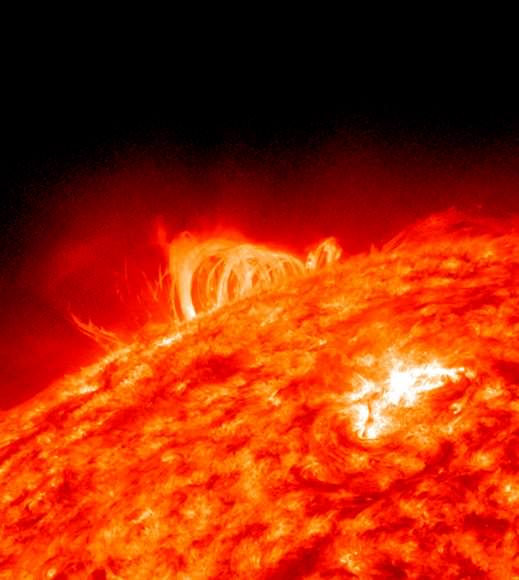Update: Well, it turns out that while it looks like Venus and Mercury are getting pummeled by Coronal Mass Ejections, the geometry might not work out, at least not for every day that is included in the video above. UT reader Steven Janowiecki brought it to my attention that just because Mercury and Venus look close to the Sun doesn’t mean they’re actually in the line of fire, as they could be well behind or in front of the solar storm. I checked with STEREO project scientist Dr. Joseph Gurman, who took a look at the data. He put together a plot for August 14, (see below) and said, “It shows that Mercury and Venus are well to the East (left) of the Sun-earth line. The large CME on the 14th originated from an active region near the west limb of the Sun, and since most CME’s are about 60 degrees of heliolongitude in width on average, it’s unlikely that that event actually passed by Mercury or Venus.” There was one large event, however, on August 7, that appeared likely to be headed in the direction of Mercury and Venus.
[/caption]
So, as it happens sometimes in astronomy, things are not always as they appear, and this exemplifies the challenges of estimating distance in astronomy.
The STEREO website has a very nifty tool where you can see the location of the spacecraft on any date, as well as where the planets are in their orbits. And there is another tool where you can see and download images from a particular day and time and even put together movies of a specific time period showing STEREO data.
Here’s the rest of the article as it ran originally:
Take a look at these Coronal Mass Ejections (CME) from the first part of August 2010, as seen by the two STEREO spacecraft. Here on Earth, we’ve had some aurorae, a result of the recent solar activity. But this STEREO imagery shows Venus and Mercury were blasted by these CMEs.
STEREO consists of two spacecraft – one ahead of Earth in its orbit, the other trailing behind. With this new pair of viewpoints, scientists are able to see the structure and evolution of solar storms as they blast from the Sun and move out through space.
These movies were taken by SECCHI, a suite of remote sensing instruments on both spacecraft consisting of two white light coronagraphs that make up the Sun Centered Imaging Package (SCIP), as well as a Heliospheric Imager (HI).
SECCHI can follow three-dimensional Coronal Mass Ejections (CMEs) from the Sun’s surface, through the corona and interplanetary medium, to impact at Earth. With these instruments, scientists are getting breakthroughs in understanding the origin and consequences of CMEs, in determining their three-dimensional structure, and more, and perhaps be able to predict space weather. Combining STEREO with the new Solar Dynamics Observatory, we’ll be learning more and more about the Sun in the next few years.
As an example of SDO’s capabilities, here’s an SDO image from earlier today showing the Sun’s limb.

Credit: NASA STEREO/NRL

